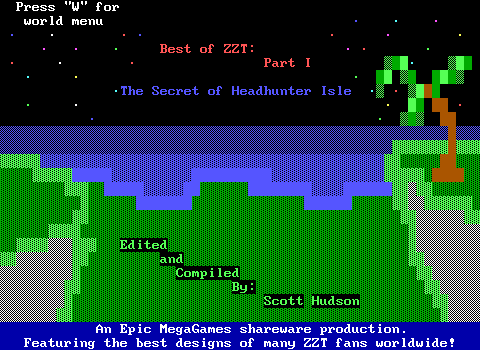Level 5 (The Good Part)
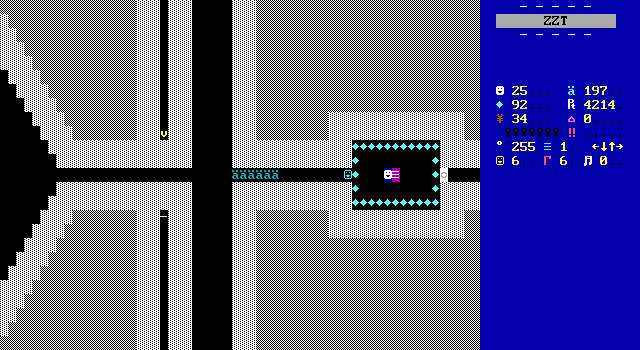
Throw everything you've read out the window. None of it is relevant upon reaching the game's fifth and final level which is basically an entirely new game just with your health and ammo carrying over.

It's such a departure that you're not even in the chambers anymore. Now you're in some sort of... "Town" of ZZT, which might not sound like it's going to be a departure from the Town influence, but most ZZT towns are hardly the town.
In fact, as long as I'm saying to disregard things, also disregard everything this man has to say. None of this "ancient civilization", "conquered by ZZT", or "dark secrets" mean anything. This is just straight up your perfectly normally ZZT town-based adventure. Like OakTown, Darby's Crazy Town, Town of Balrog!, or games which don't go so far as to put the word town in their titles. It's a bit of a shame though, games that make "ZZT" a noun within the game world as something other than a piece of software are always so appealing in their weirdness.
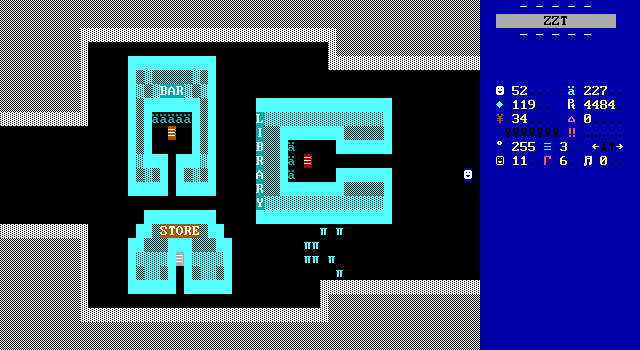
The first thing to do is see what this town has of interest. Some staples of ZZT towns are all crammed in place here. Visually, the outside world is kind of dismal. Almost every board has this white background, which combined with the cyan buildings give things a bit of a wintry vibe. At least in The Three Trials there was the excuse of weather manipulation. Nothing actually says it's supposed to be a winter hellscape or anything, just the colors are particularly drab, especially in contrast to the more vivid scenery seen the in front-half of the game.
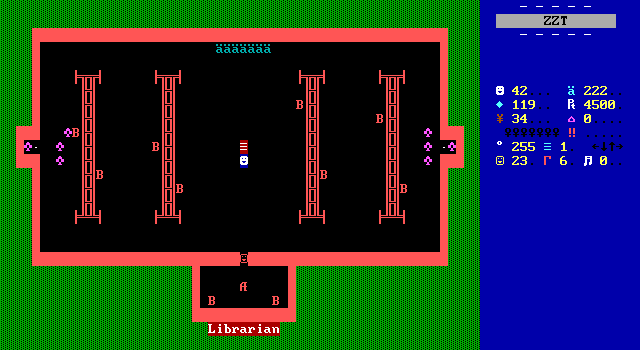
First, the library, which seems to be dealing with a nasty ruffian problem. The number of books is fairly limited, but they offer more than just the typical jokey titles, providing both useful information on the town as well as information that is so beyond helpful given how much of the game the player had to have gotten through to get here.
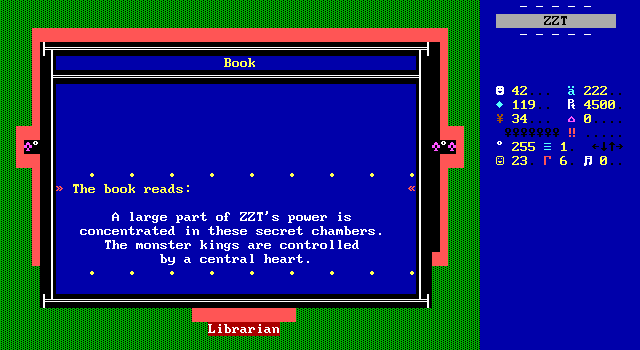
A bit late. By this point the player has already beaten both the Ruffian King and Tiger King. The "central heart" is at least something new, and while it is kind of the ultimate goal of Secret Chambers, this text is not establishing that.
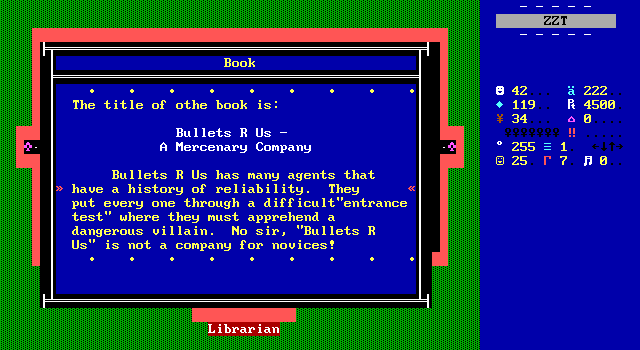
This however, is much more important. "Bullets R Us" is in the southern part of town, locked up, and effectively the source of the player's tasks while they're in town.
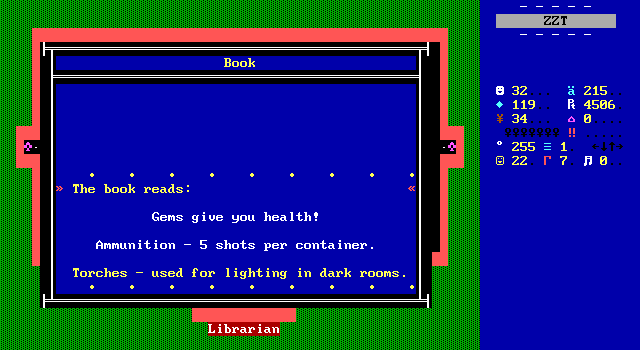
This is where I smugly say that the game is still just taking things from Town and you can't say I'm wrong.
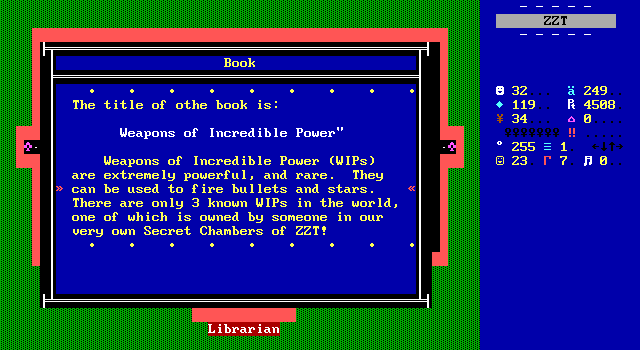
Some more exciting lore! There's a good buildup with these WIP things where you'll read about one, then see one, and then finally have to fight somebody wielding one.

Who wrote this book?
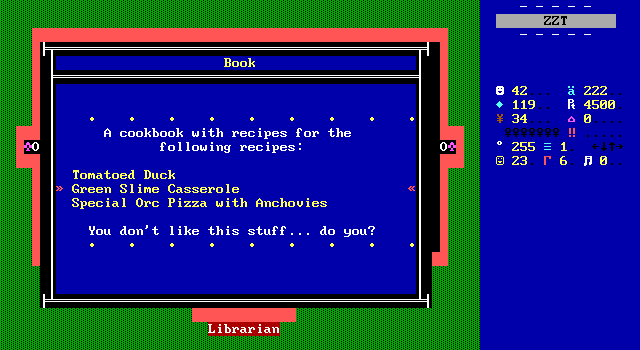
Humor!

The reading material is mandatory. The player needs to know about Bullets R Us before they can talk with this part-time librarian part-time mercenary. (*takes notes for any future tabletop RPG characters I may need to make*) Pulling now from City, it's time to bribe not the mayor, but the librarian in order to get a key to actually get inside.
Even with the information from the book, there's still not real motivation for the player to want to go there. This is just the game guiding the player along so they have a goal again now that they've escaped the secret chambers below the town.
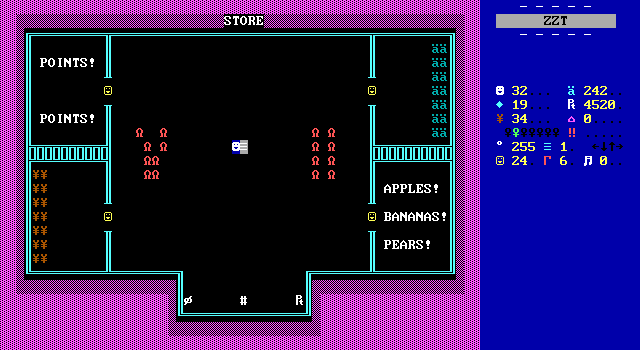
The store has a lion problem to go along with the library's ruffians. They are quickly dealt with at least, and finite in number.
The store is very nearly something that could be glossed over. You can buy ammo and torches. Food can be purchased to restore health (something very much needed by this point). High score chasers can spend their money directly on getting more points as well. This is all what you'd expect. Where things get a little more unique are in the three items along the bottom of the store. These are three unusual items: a green diamond for 100 gems, a math textbook for ten, and a very expensive painting.
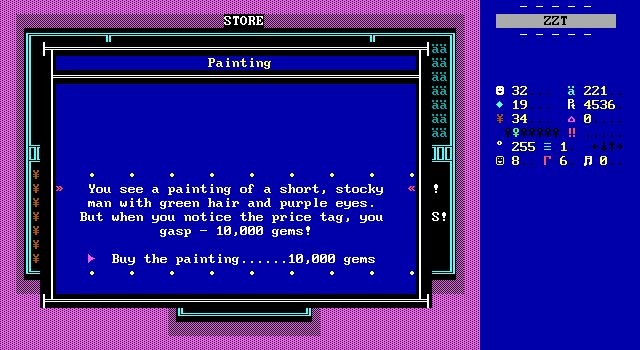
Like. Very expensive.
Of course, stores with items on display like this isn't that unusual either. As is often the case with these things, most of the items are just there to fill the space, not actually doing anything other than making you waste money if you buy them.
...Except I'm talking about the emerald and the math book. It's the 10,000 gem painting that ends up being required, which means the player needs to get a lot of cash somewhere if they're going to obtain it legally.
Prices being what they are though, there's a very real danger that if you opt to buy the emerald before heading to the library and learning that you need to bribe the librarian that you won't be able to afford the bribe and wind up unable to proceed. The town is structured in such a way that the library is the closest starting point, but a badly injured player or just one who wants to check out the other buildings instead may opt for the store first, risking their progress without even realizing it.
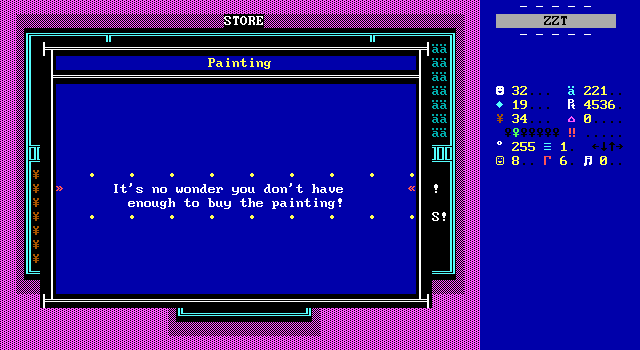
Oh, and the authors have a little fun at the player's expense if you try to buy the painting without the money.
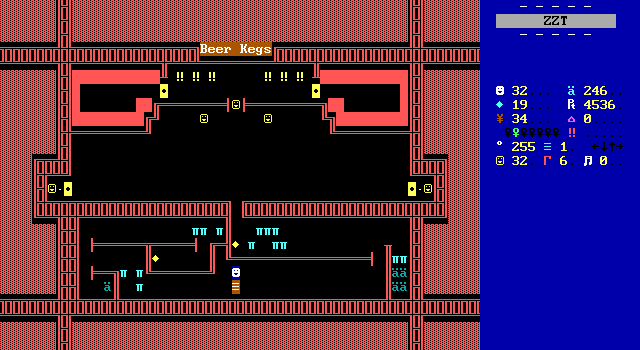
The bar keeps with the theme of everything being a dangerous place. I guess bars are more likely to be dangerous than most stores and libraries, though tigers are not the threat I'd typically associate with them.
I must say, while the outside world isn't much to look at, the linewall usage here is top-notch. Whenever I complain about interior boards that just have boring backgrounds, know that this is all it takes to improve appearances dramatically. Using the double-exclamation point character as taps is also a great look, and a fun subversion of the classic upside-down exclamation point for bottles of alcohol.
Two objects trapped behind duplicators and shut doors indicate that something is going to go down here, it's just a matter of when. Talking to the bartender lets the player buy a beer or leave a tip. The beer does nothing, but the tip provides some info about one of the other customers who just so happens to be a millionaire who made his money as a mercenary working for "Bullets R Us" in town.
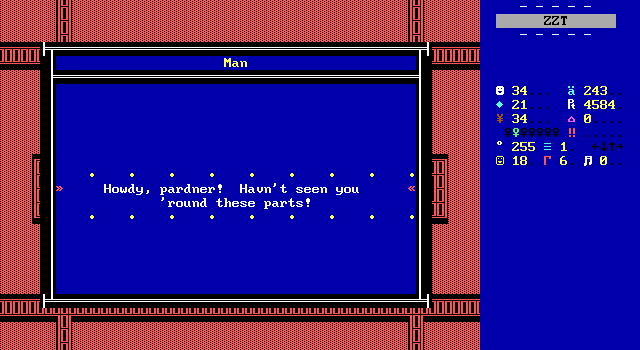
The mercenary doesn't have much to say. They're friendly at least.
I'm going to blame Chekhov's duplicators here, but after being told that this guy is a rich mercenary working for the people the protagonist seems interested in investigating, I just had to shoot him and see what would happen.
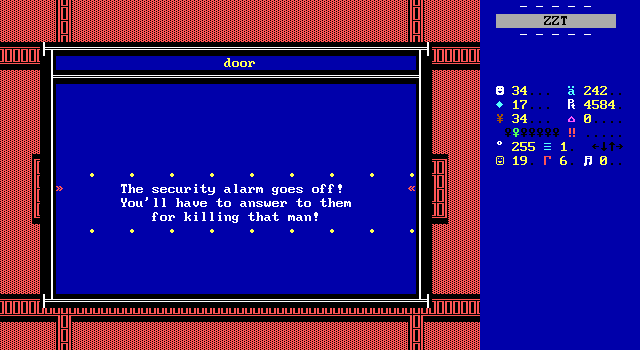
Now the doors open and duplicators can slowly fill the room with security guards who have clearly already failed.
This was just straight up murder in cold blood. Bullets R Us has not been established as a threat. The man spoke with us and was polite.
ZZT is no stranger to wanton murders. Plenty of games will code in messages and consequences for shooting objects that you're not supposed to. Heck, half the fun of Aceland is that you eventually lose the ability to not kill people by touching them. Here though, it's very much out of nowhere. This isn't an intricate scene not meant to be seen in a proper playthrough. This is required. You have to shoot this guy in order to proceed with the game.
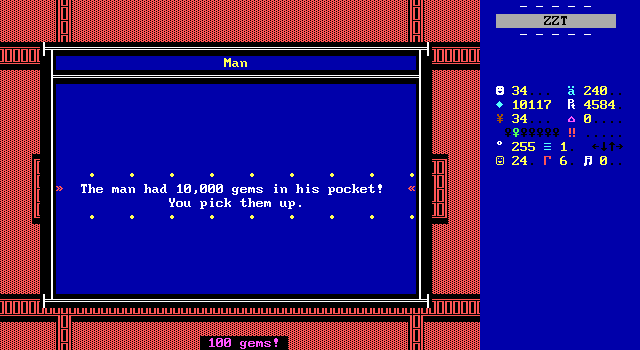
You have to kill in order to get your 10,000 gems to buy that painting which at this point the player (both the one in ZZT as well as the person playing the game) has no reason to believe they need to.
...Now shooting the other patron at the bar and taking their 100 gems is optional. (And does serve as an anti-softlock measure in case you did buy the emerald.) The guards also go down in one shot. At least the bartender is immune.
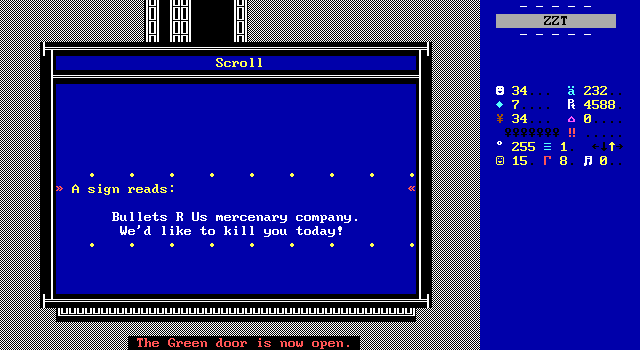
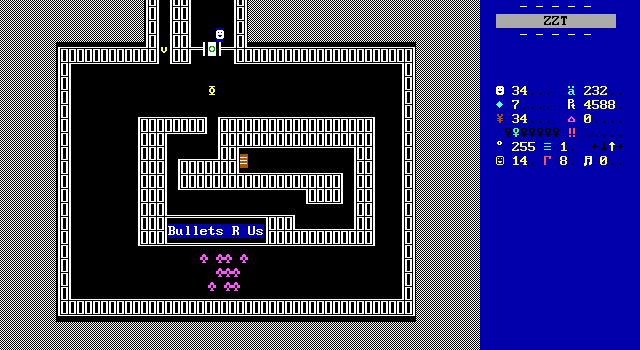
Heading south from the chambers' exit, it's finally time to stop in at Bullets R Us. As is par for the course, some enemies just had to be included, though their positioning at the bottom of the board means they're simple to ignore. The Kopps seem to really struggle with making boards that don't have creatures/bosses on them. In the more action-oriented secret chambers the constant enemies make sense. Here in town, it feels like an obligation. It's especially noticeable due to the fact that the boards are still designed like safe town boards. The enemies just happen to be plopped down onto them making the combat here feel more tedious than the earlier levels where their placement felt like it had purpose.
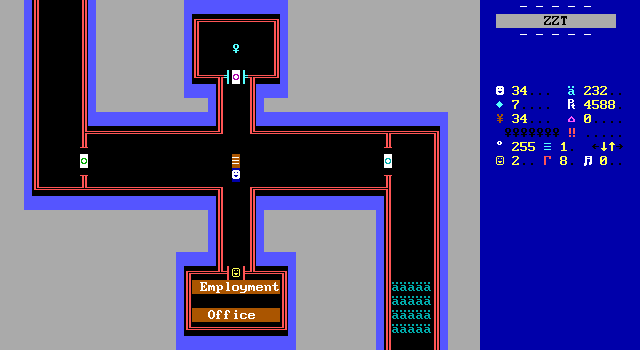
So of course, the interior of the mercenary group's headquarters is devoid. I guess they would be the type to keep it under control in their own building.
You: I'd like to apply for a job here.
Him: I don't know... This job is not for
novices. You'll have to pass the
entrance test before you get a job.
You: Entrance test?
Him: Yes, you must catch a serial killer
who calls himself "Slice." He has
green hair and purple eyes.
You: How do I start?
Him: Well, you can start by getting a
picture of him. I think you can
buy one at the store.
• • • • • • • • •
The player shouldn't be surprised about this test. The book in the library told them as much.
Now though, the town has a real purpose for the player. There's a man named "Slice" who needs to be brought to justice.
The boss meanwhile suggests the most absurd thing imaginable, that you can buy a picture of an uncaught serial killer at the nearby store. I mean, he's not wrong. We've seen it already. It costs 10,000 gems. (I actually already bought it in my playthrough since when you're given 10,000 gems, buying the thing that costs 10,000 gems seems like a no-brainer.)
I want to dwell on this picture for a minute here because it's even more absurd when you consider that while "picture" gets used as a generic term for any image, the store specifically described the item for sale not as a photograph but a painting. Did Slice model for it? Is it a self-portrait? Does it actually say that it's a painting of a man named "Slice"? If not, how would you even know that it's him?
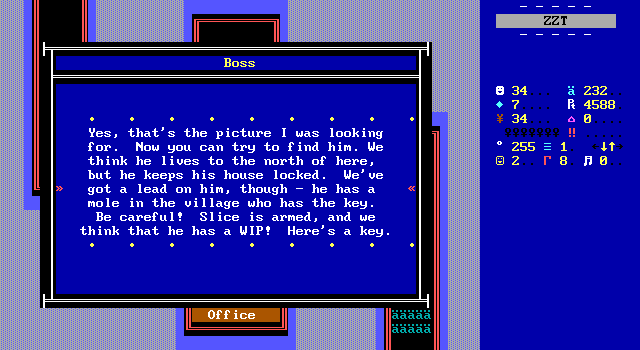
At least there's a good reason why we couldn't just look at the painting rather than buying it. It's needed to get confirmation from the boss that this is the man. At least this mercenary group has some accountability. With all the leads assembled, it's time to search the town for the mole that has a key to Slick's home.
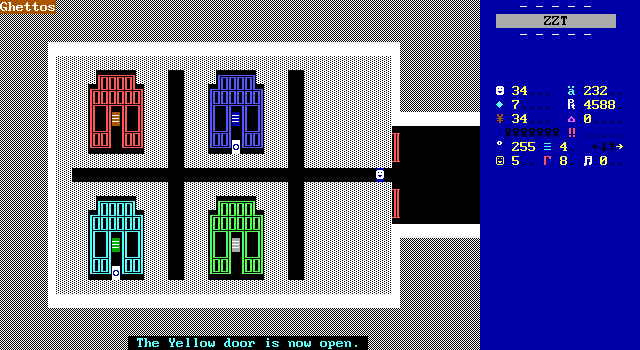
North is Slice's locked up home, south is the BRU building, east is the passage back to the chambers, so all that's left is to explore the ghetto. The buildings may be a bit on the small side, but it looks like a decent enough place. It's not like there's anywhere else to live in this town.
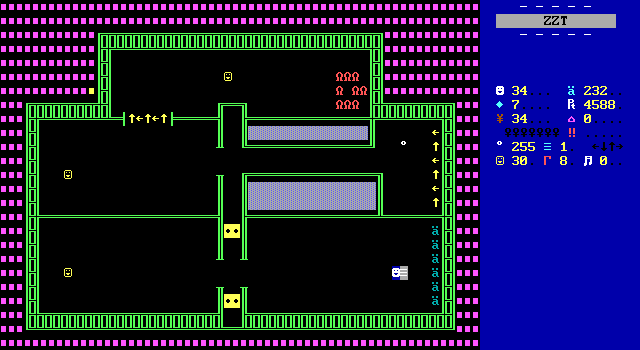
The protagonist's strategy is to just barge into any building they can and just walk up to strangers asking if they have a key to Slice's house. It's a very forward tactic.
These interiors continue to abide by the unstated rule that the player must be able to die on every board. Here though, I think it works a bit better than the library or store. Dividing the buildings up into smaller rooms makes for more threatening combat in close quarters. These buildings often have elevator objects (probably inspired by City of ZZT) that keep the player from always being able to run away completely. The use of spinning guns also cover larger ranges allowing the player to be struck from behind if they're not paying attention.
It's still not much. In this board the danger is limited to just three of the five rooms, with the far right room being pointless to go anywhere near. These might be good spots for treasures, both secret and otherwise, but as they are it's just dead ground for the bullets of only one of the spinning guns to actually cover the player.
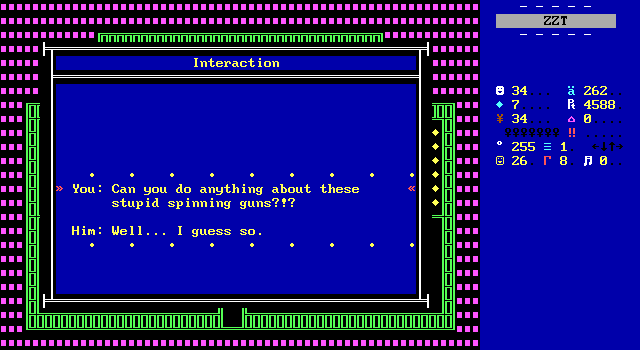
ZZT's more straightforward obstacle elements rarely get spoken of like this. Usually it's just written off as something there solely to make the game more "game", like punching a garbage can and finding a fully cooked and still hot turkey inside. Having the player actually say "why are there sentry guns firing live rounds in your house" is a departure from the accepted norm. The plea is seen as persuasive at least and this person upstairs will erase the guns afterward.
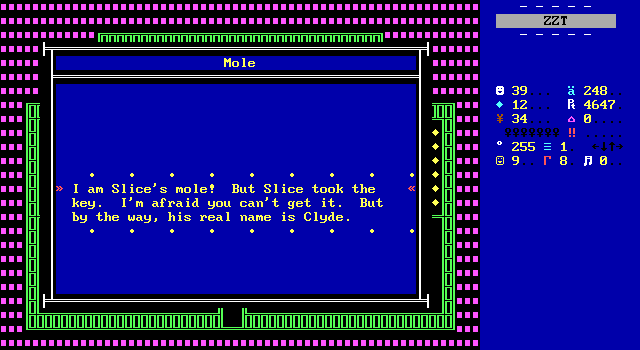
Oh hey. The mole. They are openly referring to themselves as that which is not a good thing for a mole to do.
Alas, they no longer have the key so the current plan is a bust.
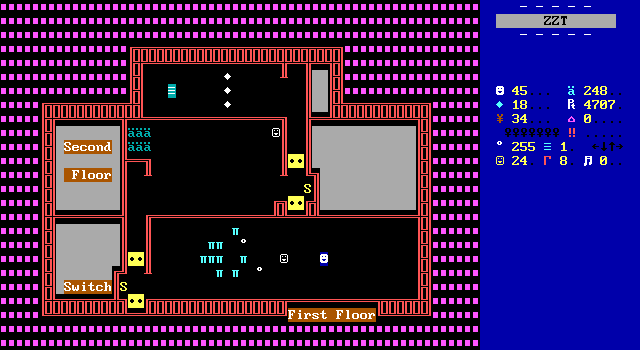
Instead, you'll have to travel to the other open home and learn about another person who also claims to have the key. Here the only threat is from the opening salvo of tigers where a helpful object provides unintentional cover. This time the elevators are manually controlled, though they lack the ability to go back down. I'm unsure why as the previous timer-based elevator was coded competently enough. Instead it means the player is forced to move through this next building in a linear fashion.
On the bright side, the other occupant is of use. She knows that her neighbor has the key and provides the player with a blue key to get inside the neighbor's house. ...Why does she have this key?
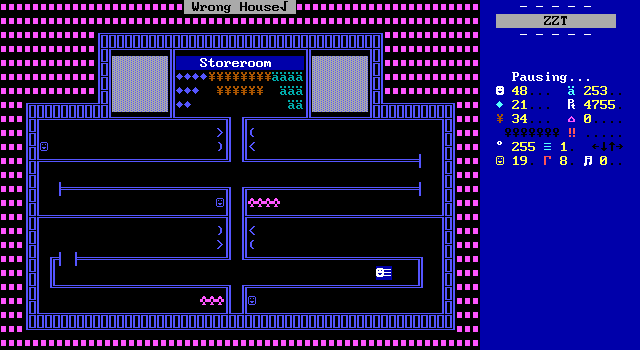
Disappointingly, there are two homes locked by blue keys, but only one key available. This is a forced guessing game where the wrong choice means reloading. All the authors had to do was include a blue key in that storeroom up top too!

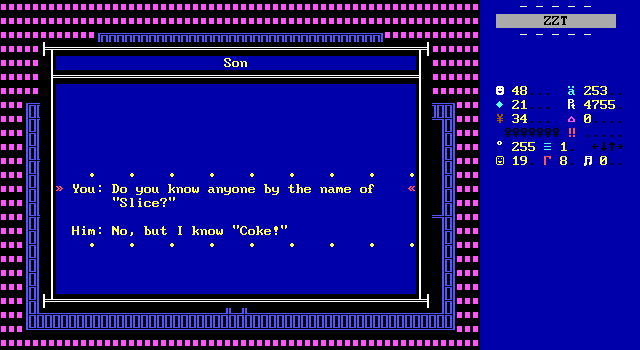
It's a shame that going to this board comes with such a heavy penalty since it has some great soda humor.

The final house returns to the first elevator design and lots of spinning guns. This time there's no way to get rid of them.
The board does impress in one way though. The person to speak with is in the attic which requires going around the elevator to reach! It's not a secret, but it feels like one.
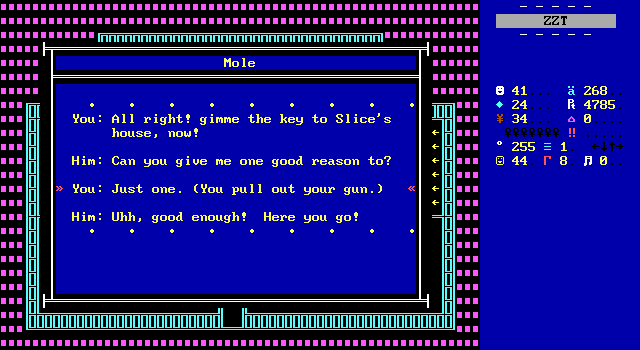
Alright, maybe it was in character to kill a man in the bar for his money.
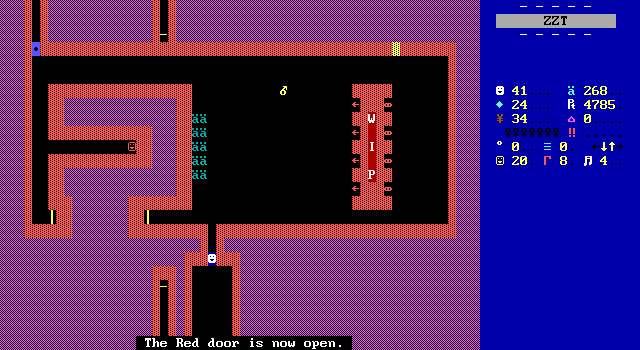
Ghetto complete, it's time to open the door and confront Slice who thankfully is home. Careful though! He's got a WIP taking up a large chunk of his home. It's inactive right now so the player can sneak up on Slice in safety.
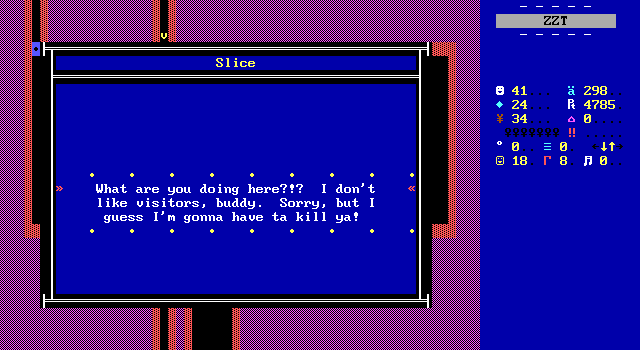

It's pretty underwhelming. Slice runs to the WIP and begins moving around the controls shooting bullets in the general direction of the player. Somewhat.
The top three arrows each shoot a bullet to the west whenever Slice "presses" the buttons (the player can also touch them if you want to play with the device yourself). The last one throws a star instead. The layout of the room means as long as you stick to the top of the room you won't be in range of 75% of this superweapon's capabilities.
Still, there's at least a nice touch in that the one yellow tile checks if the player is aligned and if so Slice stops operating the WIP and begins moving and shooting towards the player directly instead.
The bomb makes it seem like the plan is to blow up the WIP and then deal with Slice. In fact, the WIP doesn't matter at all. It's Slice that needs to be caught in the blast, and with only one try it's very possible to miss.
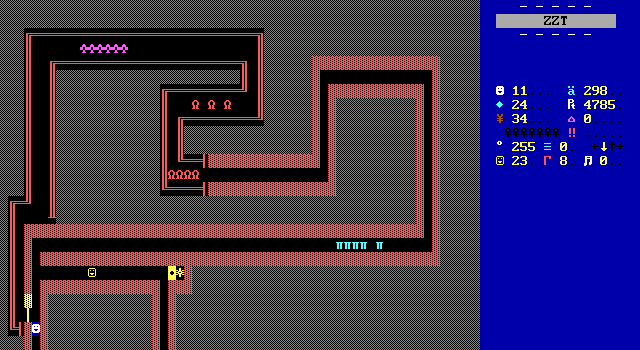
Once bombed, Slice calls the player an idiot and runs off into the back of his home beginning a cute little chase sequence. Again the yellow mark is an object that checks when the player passes it, starting the next part of the chase where Slice runs back down the right path and instead leaves the player to outrun...
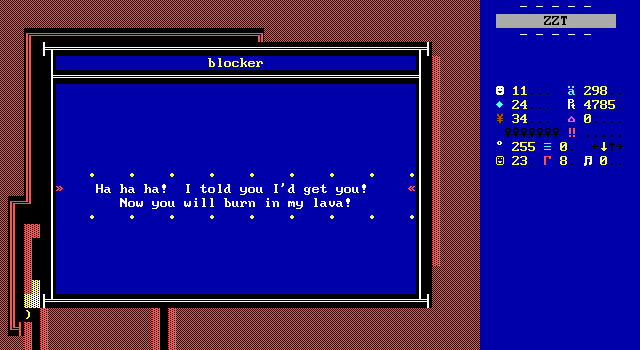
lmao
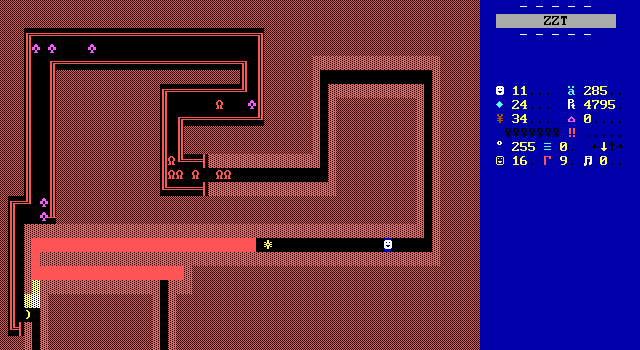
So it's a slime chase like one seen in an earlier level, just with instant death rather than a lot of tunneling if you move too slowly. The player moves twice as fast and the tunnels are so narrow that your shots will only miss if an enemy goes behind a corner making for a slow lap around the board. It just happened to be timed perfectly so that the inevitable smile on your face from the idea of somebody keeping lava in their home for this situation will fade just as you exit it and never think of it again.
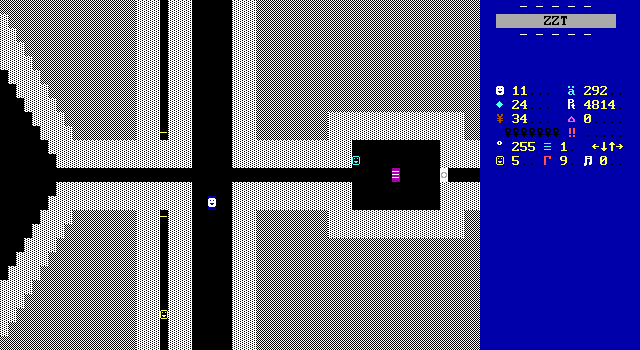
I respect the commitment to the chase. You get to watch as Slice runs through the alternate tunnel in his home and down the road to Bullets R Us. I didn't get a screenshot in time, but Slice starts in the top half, then disappears with another object appearing to fake going through the transporter! That's a commitment to detail especially since Slice starts only a few tiles from the transporter and not on the top of the screen. The goal is for him to have a lead of the player until the very end, and I suspect most games would've just had one object on the bottom and called it a day.
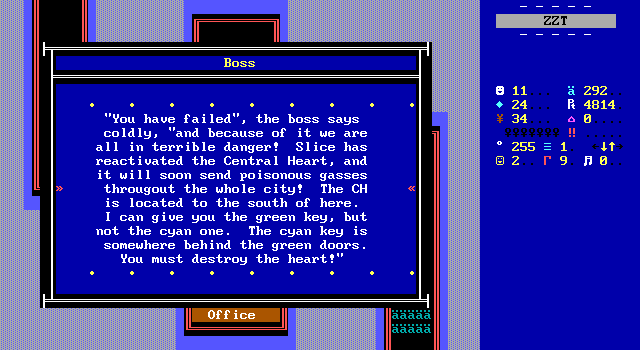
Slice is seen entering the BRU building, but is gone by the time the player gets inside. The boss of BRU provides the next key, but there's one more board before you can head to the central heart and save everybody from poison gases being released into the city.

The final challenge is a depressing return to form of the kind of bland style of the earlier part of the game. Honestly, even by the standards of the first four levels this is a shoddy board. It's dark and just a purple maze of purple ruffians to get a purple key. It's way too bland and means the fast paced chase sequence comes to an abrupt stop here.
This would have gone down smoother if this entire board was erased and the player could deal with Slice and the heart immediately. In fact, the sudden lack of urgency got me to stop and think for a moment, and head to the store to spend all my remaining gems on more health.
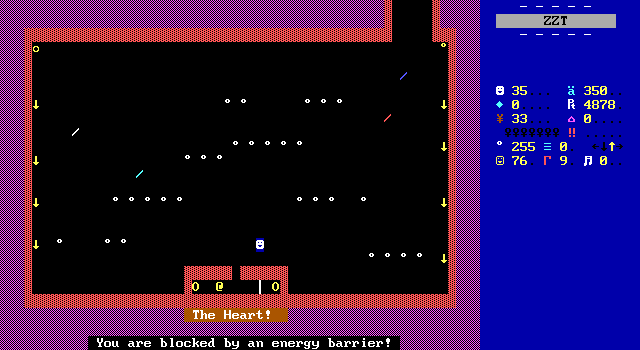
The final fight is also a flop. The heart paces back and forth (and doesn't use a heart character for some reason!) shooting upwards at times, and when it hides behind its little barrier the gap allows stars from the adjacent objects to funnel out. This also lets the play funnel themselves in and unload on the heart if they can stomach the damage.
It's probably the way to go regardless as other objects outside also throw stars. The spinning guns thankfully stick to bullets though that means just finding a safe row. The fight offers at least one interesting idea in "energy barriers" that are just small groups of invisible objects that shuffle around. It at least means the player can't reliably just shoot the heart from the across the room. They're thankfully harmless to touch.
The heart's destruction gets little celebration. There's a message and a flag set. No animations, no effects, no information on Slice. It makes for a very low energy ending where all that remains is to turn around and speak with the boss of BRU to let him know of your success.
Him: Congradulations! You have managed to
destroy the Central Heart! You have
passed the entrance test with flying
colors! Slice was captured by the
police and is now serving x years
in prison where x is the area of a
circle with radius 10 divided by 0!
You: Uh... I think there's something you
should know. I don't want this job.
All I need is the white key to get
out of these Chambers!
Him: Well, I guess I owe you one. All
right, here it is!
• • • • • • • • •
One last Town reference for the road. Slice is captured off-screen resulting in the actual villain that the player may have some personal interest in defeating just being brushed aside. The story is over.
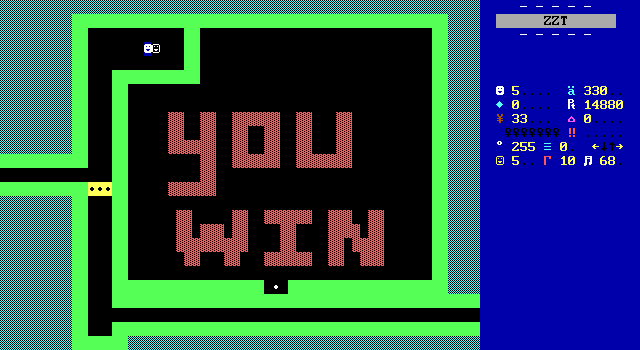
No, but really, it is vitally important that all roads leads to Town. The ending ceremony here is just as it is in Town with an object congratulating the player. It does mix things up a little by hinting at a sequel, telling the player their next task is to defeat the "Lion and Bear Kings". As this is the only world credited to either of the Kopps, it looks like that never panned out.
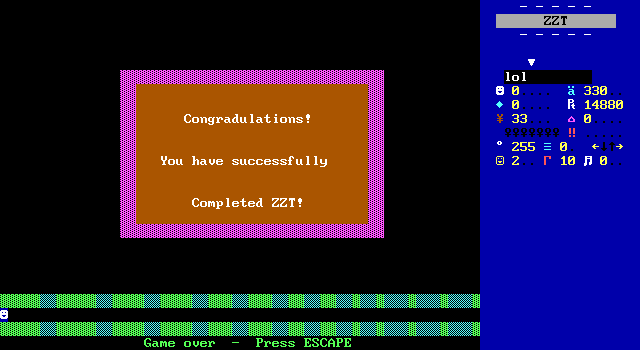
Most of this game is just a case of monkey see monkey do, but the ending boards really are trying to be so utterly identical to Town when I really wish they weren't.
Postgame
If you do manage to complete the Caves of Logic and collect all the runes of virtue, the guardian of the warp zone does mention that there's more to the ending board than it seems. By shooting immediately after entering the board there will be time for a bullet to hit an invisible object which prevents the game from actually ending, finally allowing players to achieve their dreams of walking down the hallway on the last board of Town.
For all the inspirations/homages/borderline theft of Town, I genuinely love this. Like those moments where the player is able to go outside of the main play area this feels like you're doing something you weren't meant to do, despite being fully intended by the authors. What lies beyond could be anything...
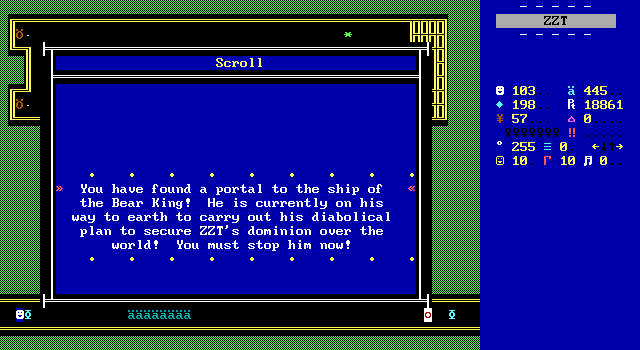

Optional superboss! Optional superboss!
No sequel required, the Bear King is right here, and he really is the toughest fight in the game by far. Ironically, he's more of a ruffian than a bear, opting to charge at the player when aligned. When he's charging he moves at cycle one and becomes immune to bullets. Since he's so eager to charge, you really have to lead your shoots and then stay out of his way and hope that he moves into them. Let him move a little too long and he'll toss in a star for good measure.
The ricochets' ability to bounce bullets doesn't help all that much due to the invulnerability when charging, though they are useful just as walls to end charges faster. I had some measure of success playing matador, letting the Bear King charge, dodging at the last moment, and then firing a bullet at his back while he was still charging before stepping away to ensure he wasn't invincible by charging in a different direction immediately after hitting a wall/ricochet.
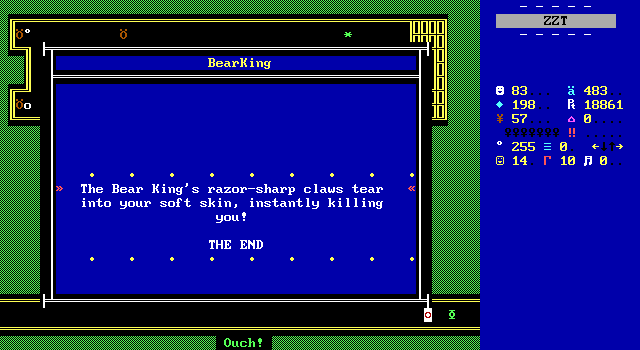
Still, it was a dangerous plan. If the Bear King actually catches the player it's an instant game over, so the strategy is not without risk.
The Bear King takes eight shots to defeat, and moves out of the way whenever he is shot so stun-locking isn't an option. The instant death may be a tad much most of the time, but as a secret boss for those who really go all out in trying to find everything Secret Chambers hides I think he's a pretty good one!
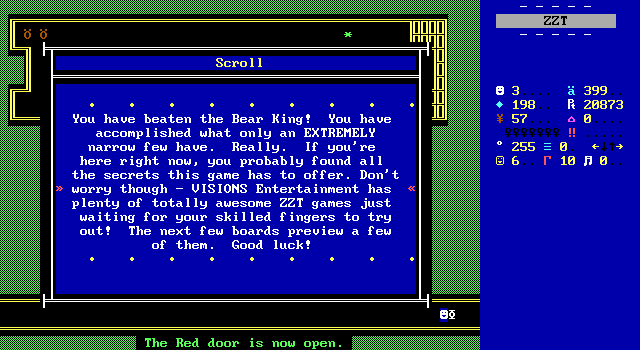
Sure you get a bunch of points for defeating the Bear King. The true prize though is that you get to browse some ads for ZZT games that may or may not have ever been released. For me at least, this is the perfect bonus.
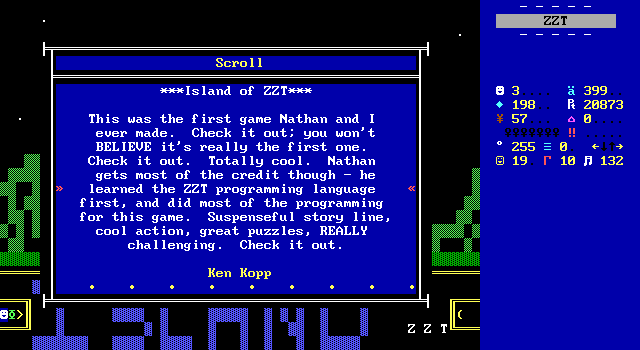
Legit though, these are some shockingly good presentations of games with high quality music and well-made effects. Most of this game doesn't feel very 1997, but the extra content at the end definitely does. This sort of capability isn't really seen anywhere else in the game proper (barring the music from getting the Runes of Virtue treasure) making it hit really hard when you do get to see it.
P.S. By the way, this game was nearly
completed by the time the Disney
movie was even heard of. I did
NOT steal the name, and it has
NOTHING to do with the movie.
Overshadowed thanks to Disney. Ain't that just the way.
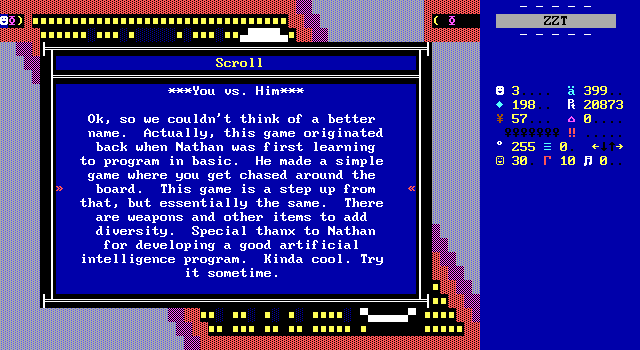
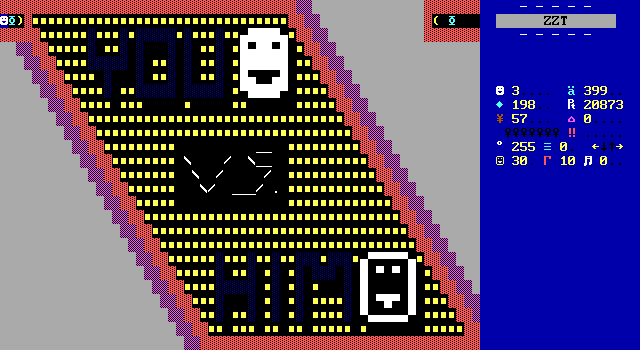
BASIC! Also artificial intelligence. I love it.
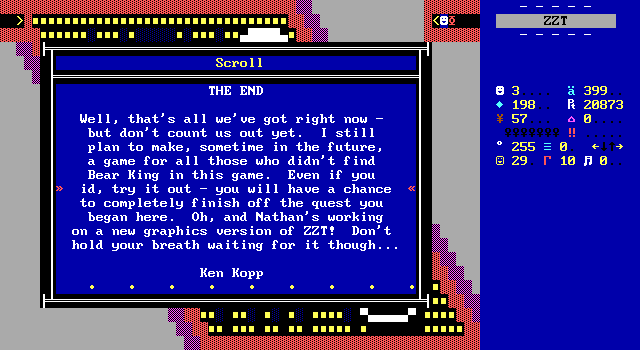
And of course the promise of all ZZTers that begin learning to code in a more powerful language: The announcement of a project to make a newer better ZZT.
Again though, some excellent music caps things off. It's a shame that the quality of the music is this good and it's all hidden away where only those really dedicated to the game will experience it.
Final Thoughts
Kind of an odd one really!
Secret Chambers starts off in such an impressively unoriginal fashion that any time it does something that isn't seen in the original worlds it turns into a celebratory moment. It takes so long for this game to develop its own personality, and by that time you're more than halfway through. Yet, even when it is just "more Town with less quality", it's still a cake, and that's hard to turn down. I wouldn't strongly recommend this one, though I can totally understand how somebody would have played this when they were younger and got a lot of enjoyment out of it. For one thing, it's far easier than the games it's emulating, which when you consider how long it took me as a child to be able to conquer Town or Monster Zoo, that's honestly pretty appealing. For the most part, what Secret Chambers offers the player is a easier, though not too easy remix of concepts seen in the official worlds. It gets rid of the complex slider puzzles, invisible mazes, explosion tunneling, and so on, leaving the player with an almost exclusively action focused take on these more difficult world.
That's appealing to a child, but those benefits aren't nearly as strong for an older audience like the one you'd find playing ZZT worlds today. For the vast majority of folks, Town can be completed over the course of an afternoon with the only real threat being saving in a soft-locked position. Secret Chambers unfortunately still has that with its needless red key "puzzle" as well as a fake key in a board inspired by Monster Zoo. If you're particularly craving some truly old-school ZZT action where the focus is on the lions and tigers above all else then there is something here to enjoy. However unless even the slightest bit of extra complexity turns you away you'd likely be better served playing the other official worlds contained in Best of ZZT and ZZT's Revenge, then branching out to a wider variety of early classics from there.
Ken and Nathan Kopp stick a bit too closely to the rules for my tastes, and I find this game ultimately pretty held-back from its true potential because of it. The back half of the game shows much more promise with it's more cohesive motivation for the player, introduction of characters and a story to tell about them, plus that weird kind of creativity seen when authors feel free to experiment and come up with ideas like the WIP. The second half is honestly still a fairly average adventure, but one that feels more free to do its own thing. Truth be told neither half is all that special making this a pretty average ZZT world overall. You can do significantly worse to be sure, but you can also quite easily do so much better.
A lot of the optimism for the game comes specifically because the bar was set pretty low for so much of it. The Runes of Virtue are a neat touch. I enjoyed stumbling across a secret here and there, though more would have been welcome. (Looking in the file viewer it's not a matter of me missing a bunch). The potential is laid bare throughout the journey, and the quality of the previews for other games in the extended ending sequence make me wish we had more work from these two. This is a good first effort with a clear path forward to better and more complex things, that we just don't have access to today. I'd be quite eager to try a later creation by this duo if one were ever uncovered. Until that time though, their ZZT legacy is one of many that showed some promise, but didn't last long enough to fulfill it.

